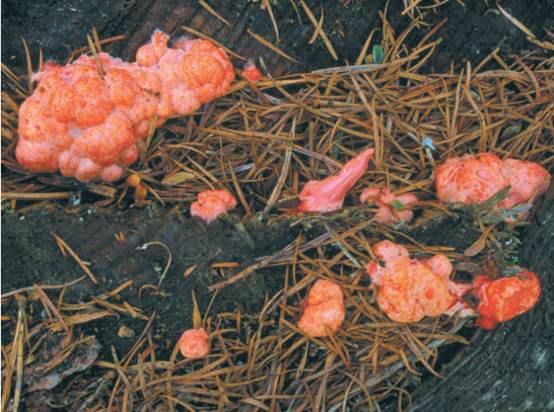
Slime Molds
 المؤلف:
Farr, M. L
المؤلف:
Farr, M. L
 المصدر:
How to Know the True Slime Molds. Dubuque
المصدر:
How to Know the True Slime Molds. Dubuque
 الجزء والصفحة:
الجزء والصفحة:
 30-10-2015
30-10-2015
 2685
2685
Slime Molds
There are two major unrelated phyla of slime molds. The Myxomycota are the true (plasmoidal) slime molds, and the Dictyosteliomycota are the cellular slime molds. Both were formerly classified as fungi but are now considered protists. Slime molds are often found on old, well-rotted logs because there they can find the moisture and bacteria required for survival. Their small, delicate fruiting bodies tend to be fungal in appearance. Most of the fruiting bodies are only a millimeter or two in height, and therefore often difficult to notice.
Myxomycota
A myxomycete exists in nature as a plasmodium, a multinucleate blob of protoplasm up to several centimeters in diameter, without cell walls and only a cell membrane to keep everything in. It resembles a large amoeba and feeds much the same way, by engulfing its food (mostly bacteria) with pseudopodia (“false feet”), in a process called phagocytosis. Thus the slime mold ingests its food and then digests it. (In contrast, true fungi have cell walls and digest their food externally before ingesting it.) When the plasmodium runs out of food, or environmental conditions become harsh, fruiting bodies form. These fruiting bodies produce dormant, resistive spores. These later germinate to form uninucleate myxamoebae or flagellated swarm cells. These later fuse and then divide mitotically to form a plasmodium, completing the life cycle. Myxomycetes are important scavengers in dark, damp parts of the ecosystem. Occasionally, during rainy periods, large plasmodia (up to a few meters in diameter) crawl out of the woods and into people’s lawns and gardens. These plasmodia were the inspiration for the science fiction movie The Blob and are eaten in parts of Mexico.

Pillows of the coral-colored slime mold Myxomycetes grow on damp wood.
Dictyosteliomycota
The Dictyosteliomycota are also known as the social amoebae. Their life cycle is considered among the most bizarre among microorganisms. It begins with free-living amoeboid cells (not to be confused with the Amoebae); there is no true plasmodium. As long as there is enough food (usually bacteria) the amoebae thrive. However, when food runs out, the amoebae send out chemical signals to surrounding amoebae. Next, they stream toward a central point and form a sluglike multicellular pseudoplasmodium, which can then migrate like a single organism. When conditions are right, the pseudoplasmodium stops migrating and forms a multicellular fruiting body. Some of the cells become spores that disseminate, while the rest form stalk cells whose only function is to raise the spores up into the air to be more easily caught in air currents.
The Dictyosteliomycota pose an interesting challenge for evolutionary theory, since some of the cells (in the stalk) actually seem to sacrifice their own reproductive potential so that others (the spores) can be transported to a new location where there is more food and they can grow again. This altruistic sacrifice would seem to be counter to the reproductive interests of the cells that became the stalk (because they never reproduce) and genes for stalk-forming behavior would therefore be selected against. It may be maintained if the spore cells are closely related to the stalk cells (and thus both have the stalk-forming genes) or if the allocation of cells to spore versus stalk is random, so that genes for stalk formation are preserved over time. However, evidence suggests that the position of the cells in the slug and thus in the fruiting body is determined by the timing of their coming into the aggregation stream, rather than by genetics.
References
Farr, M. L. How to Know the True Slime Molds. Dubuque, IA: William C. Brown Publishers, 1981.
Keller, Harold W., and Karl L. Braun. Myxomycetes of Ohio: Their Systematics, Biology and Use in Teaching. Columbus, OH: Ohio Biological Survey, 1999.
Raper, Kenneth B. The Dictyostelids. Princeton, NJ: Princeton University Press, 1984.
Stephenson, Steven, and Henry Stempen. Myxomycetes: A Handbook of Slime Molds. Portland, OR: Timber Press, 1994.
Volk, Thomas J. Tom Volk’s Fungi. http://www.wisc.edu/botany/fungi/volkmyco .html.
 الاكثر قراءة في الفطريات
الاكثر قراءة في الفطريات
 اخر الاخبار
اخر الاخبار
اخبار العتبة العباسية المقدسة


